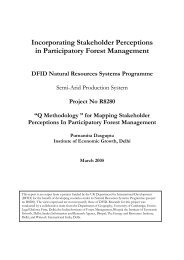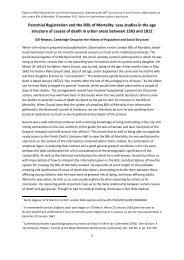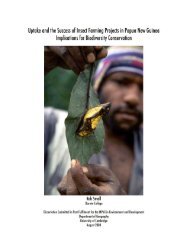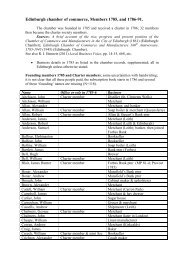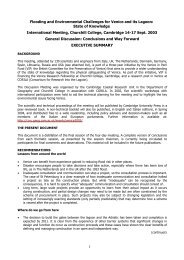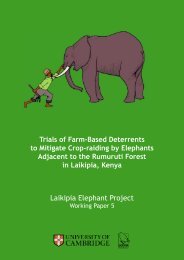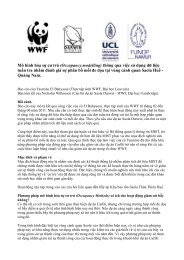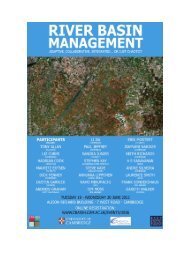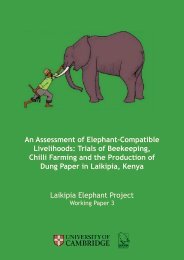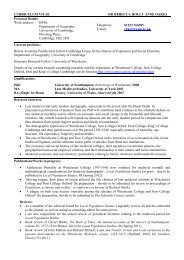Presentation
Presentation
Presentation
You also want an ePaper? Increase the reach of your titles
YUMPU automatically turns print PDFs into web optimized ePapers that Google loves.
Distribution of arsenic in groundwater in<br />
three states of India and geochemical<br />
data from an arsenic-affected area of<br />
Ballia District, Uttar Pradesh<br />
Ross Nickson, UNICEF Kolkata<br />
Dr. Nalini Sankararamakrishnan,<br />
Indian Institute of Technology Kanpur
<strong>Presentation</strong> Outline<br />
• Distribution of As in<br />
groundwater used for<br />
drinking in India:<br />
– West Bengal state<br />
– Bihar state<br />
– Uttar Pradesh state<br />
– Assam, Jharkhand and<br />
Chhattisgarh states not<br />
covered<br />
• Geochemical data from<br />
Ballia District, Uttar<br />
Pradesh state<br />
UNICEF<br />
• Conclusions
Overall area under discussion<br />
UP<br />
Bihar<br />
Assam<br />
Chhattisgarh<br />
Jharkhand<br />
WB<br />
UNICEF
West Bengal state<br />
• 132,262 govt. handpumps<br />
tested using SDDC method<br />
with AAS confirmation<br />
• 25.5% > 50µgl -1 (India int.)<br />
• 57.9% > 10µgl -1 (WHO)<br />
• 79 blocks in 8 districts<br />
• Est. 3.9 million people<br />
exposed (>50µgl -1 )<br />
• 1.45 million (37%) provided<br />
with alternative sources<br />
• GoWB US$500 million<br />
‘Masterplan’ underway to<br />
provide PWSS<br />
• Communication required to<br />
UNICEF<br />
ensure behaviour change<br />
Bihar<br />
West<br />
Bengal<br />
Bangladesh
Assam state<br />
• Initial testing of 5,729<br />
sources from 22 districts<br />
• Focus on 25km proximity<br />
of Brahmaputra<br />
• 6.3% > 50µgl -1<br />
• 26.4% > 10µgl -1<br />
• 72 blocks in 18 districts<br />
affected (>50 µgl -1 )<br />
• Anomalous that Tinsukia and Dibrugarh not affected<br />
• Blanket testing of govt. sources now ongoing using 80<br />
Arsenator’s backed up with laboratory confirmation<br />
(SDDC/AAS)<br />
UNICEF
Bihar state<br />
• To date 66,623 sources tested<br />
using FTK (laboratory confirmation<br />
with SDDC method)<br />
• Focus on areas within 10km of<br />
Ganga<br />
• 10.8% > 50µgl -1<br />
• 28.9% > 10µgl -1<br />
• 50 blocks in 11 districts affected (><br />
50µgl -1 )<br />
• Testing ongoing, additional testing<br />
required along Gandak river<br />
floodplain<br />
• GoB providing PWSS, RWH and<br />
UNICEF<br />
sanitary wells
Bihar state<br />
% sources >50ug/l<br />
Nepal<br />
Uttar<br />
Pradesh<br />
Bihar<br />
West<br />
Bengal<br />
UNICEF<br />
Jharkhand
Uttar Pradesh state<br />
• 103,178 govt. sources tested<br />
with FTK in 321 ‘at risk’<br />
blocks in 51 districts to date<br />
• Laboratory confirmation with<br />
Arsenator/SDDC method<br />
• 1.3% > 50 µgl -1<br />
• 9.6% > 10 µgl -1<br />
• To date 66 blocks in 20<br />
districts affected (>50 µgl -1 )<br />
• Testing ongoing<br />
• GoUP providing PWSS and<br />
deep handpumps<br />
UNICEF
Uttar Pradesh state<br />
% sources >50ug/l<br />
Delhi<br />
Nepal<br />
Uttar<br />
Pradesh<br />
Ballia<br />
District<br />
Bihar<br />
UNICEF
Jharkhand state<br />
•Blanket testing of govt. and private sources in<br />
two blocks of one district (Sahibganj)<br />
•9,777 sources tested to date<br />
•3.5% > 50 µgl -1 to date<br />
•7.7% > 10 µgl -1 to date<br />
•Also 32,466 sources tested for arsenic in<br />
schools across entire state<br />
•As expected Sahibganj District found worst<br />
affected most other areas not affected<br />
UNICEF
Jharkhand state<br />
Bihar<br />
West<br />
Bengal<br />
UNICEF
Jharkhand state<br />
Bihar<br />
Jharkhand<br />
West<br />
Bengal<br />
UNICEF
Geochemical data collection:<br />
Methodology<br />
Sample collection &<br />
preservation<br />
• Pre monsoon, post monsoon<br />
and winter season<br />
• Acidified to pH 2 using HCl for<br />
Arsenic and Fe(II)<br />
• Anion and ammonia analysis<br />
left unacidified and refrigerated<br />
Study Area<br />
Analysis<br />
• Arsenic by SDDC<br />
Spectrophotometric Method<br />
• Total arsenic was analyzed at<br />
10% HCl<br />
• UNICEF As(III) was analyzed at pH 5<br />
using (0.6M)acetate buffer
Present Scenario<br />
Arsenic<br />
5 0 0<br />
A r s e n i c<br />
As (ppb)<br />
600<br />
400<br />
200<br />
A s ( p p b )<br />
4 0 0<br />
3 0 0<br />
2 0 0<br />
1 0 0<br />
0<br />
0<br />
Sulfate<br />
1 . 6<br />
N i t r a t e<br />
Sulfate (mg/l)<br />
30<br />
20<br />
10<br />
0<br />
N i t r a t e - N ( m g / l )<br />
1 . 2<br />
0 . 8<br />
0 . 4<br />
0<br />
Phosphate<br />
1 0<br />
A m m o n i a<br />
Phosphate<br />
(mg/l)<br />
6<br />
4<br />
2<br />
0<br />
A m m o n i a ( m g / l )<br />
8<br />
6<br />
4<br />
2<br />
0<br />
1 4 7 1 0 1 3 1 6 1 9 2 2 2 5 2 8 3 1 3 4 3 7 4 0 4 3 4 6<br />
UNICEF
Ground water chemistry in the study area<br />
Fe (mg/l)<br />
25<br />
20<br />
15<br />
10<br />
5<br />
0<br />
As Vs Fe<br />
R 2 = 0.5654<br />
0 100 200 300 400 500<br />
As (ppb)<br />
Ammonia (mg/l)<br />
10<br />
8<br />
6<br />
4<br />
2<br />
0<br />
As Vs Ammonia<br />
R 2 = 0.3672<br />
0 100 200 300 400 500<br />
As (ppb)<br />
1.5<br />
As Vs Nitrate-N<br />
60<br />
As Vs Sulfate<br />
Nitrate - N (mg/l)<br />
1<br />
0.5<br />
0<br />
0 100 200 300 400 500<br />
Sulfate (mg/l)<br />
40<br />
20<br />
0<br />
0 100 200 300 400 500<br />
As (ppb)<br />
As (ppb)<br />
• pH 7.3 – 7.5, ORP (-100 to -175 mv)<br />
• IM II hand Pumps (30 - 35 m deep) As conc. from 0 – 428 µgl -1<br />
• No seasonal variation of arsenic concentration<br />
UNICEF<br />
• Reduction mechanism is the predominant mechanism governing the
Conclusions<br />
• Arsenic found at >50 µgl -1 in groundwater used for<br />
drinking in at least 269 blocks of 58 districts of India<br />
• Testing ongoing in some areas and complete picture<br />
yet to emerge<br />
• Overall, testing of private sources still required<br />
• Better communication action required in some areas,<br />
especially West Bengal<br />
• Field testing backed up by lab. confirmation is a good<br />
system for testing a large number of sources in a<br />
reasonable timescale without compromising on<br />
accuracy<br />
• Upstream of West Bengal most ‘at risk’ areas for arsenic<br />
occurrence are geologically younger sediments with<br />
UNICEF<br />
reducing conditions, both As(III) and As(V) found in UP
UNICEF<br />
Thank You




